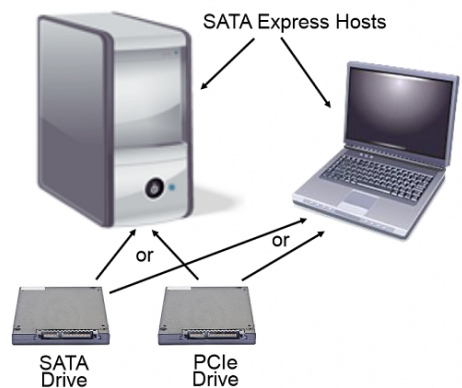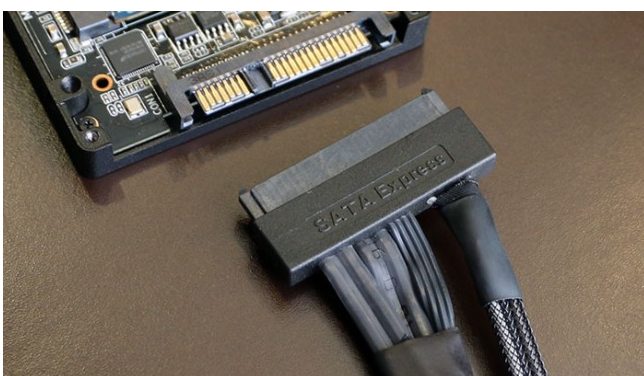New Interface for HDDs: SATA Express at PCIe Speed
Demontrated by WD
This is a Press Release edited by StorageNewsletter.com on June 5, 2014 at 2:56 pmWD was demonstrating the first PCIe HDDs at Computex Taipei, June 3-4, 2014.
Enabled with key technology partners, WD’s prototype introduces the new SATA Express interface, a form of PCIe technology, which is offered on recently launched Intel series-9 chipset motherboard platforms. The SATA Express interface provides a roadmap for faster speeds, lower power consumption and increased flexibility for future OEM designs.
The road to the world’s first demonstration of SATA Express has been in development for almost three years. In 2011, SATA-IO, the group responsible for charting the future of SATA, announced that it was developing a new specification that would fundamentally change the core technology behind SATA by melding it with the more advanced PCIe computer interface. In 2013, the SATA Express specification was announced; and just one year later, WD and selected partners have realized a prototype of what is expected to be the next generation of storage technology.
By moving to PCIe, the industry marries the world’s most popular storage bus with the world’s most popular computer bus. This union provides a growth path to innovate new capability, while preserving the ability to plug legacy SATA drives into new SATA Express based computers. In another innovation, SATA Express allows cable connections with lower costs, by removing the PCIe Sync line via SRIS (Separate RefClock with Independent SSC), which lowers the overall cable cost.
“WD has been at the forefront of SATA technology, and we see a vibrant growth path for adoption of the future SATA Express roadmap,” said Matt Rutledge, SVP, storage technology, WD. “SATA will remain a standard for many years in many applications, and for customers who want to discuss a future beyond vanilla SATA, WD is ready to plan the future with them.”
The SATA Express interface was demonstrated in systems from WD’s partners at Computex to show the operational interface with their new platforms. This SATA Express infrastructure allows customers to work with SSDs, SSHDs, and HDDs on a single common bus.
WD’s demonstration prototype leverages standard AHCI drivers and is compatible with all known, currently supported client OS releases.
“SATA Express is a breakthrough interface for internal storage. As a pioneer and leading provider of SATA Express host solutions, ASUS is glad to see exciting new devices demonstrated in the market. The SRIS-enabled SATA Express technology has been carefully engineered in selected ASUS 9 Series motherboards for great compatibility with SATA Express devices. The complete ASUS SATA Express solution together with the WD HDD will be showcased at the ASUS booth M0410,” said Joe Hsieh, corporate VP and GM of ASUSTeK Computer Inc.‘s motherboard business unit and desktop business unit.
“With the launch of the Intel 9 series chipset, GIGABYTE is excited to bring several new motherboards to the market that supports the very latest SATA Express technology,” commented Colin Brix, director of marketing of GIGABYTE TECHNOLOGY Co., Ltd‘s motherboard business unit. “As an industry leader in the storage space, WD is one of the first vendors to demonstrate SATA Express devices, and GIGABYTE is thrilled to be able to demo one of their latest drives at Computex so we can show our customers just how much faster PCIe based SATA Express is than previous generations.”
Comments
Since the first HDDs, manufacturers have tried to accelerate the transfer rate of their devices with more and more faster interfaces. At Computex Taipei, WD demonstrated the fastest one, the new SATA Express interface, a form of PCIe technology, up to 2GB/s.
The host accepts one or two SATA drives or one PCIe drive with up to two lanes of PCIe. Protocols that support SATA Express, initially standardized as SATA 3.2, include SATA, AHCI and NVMe.
But there is some limit in HDDs. The transfer rate is directly in relation with the areal density of the disk platters and mainly the rotational sped of the drive. But this specification has not been enhanced since many years, culminating at 15,000rpm. SSDs with no mechanical parts have here a big advantage and can transfer data much faster especially with PCIe 3.0 architected with NVMe.
History
HDDs need an interface to computers. The first ones were huge proprietary controllers connected to mainframes.
ST-506 was the first interface for PCs introduced on the first 5.25 inch hard disk drive
in 1980 by Seagate Technology (then Shugart Technology), at 5MB HDD, and then ST-412 late 1981 for double capacity HDDs.
Enhanced Small Disk Interface (ESDI) was an industry standard interface similar to ST412 supporting higher data rates between the processor and the drive.
Integrated Drive Electronics (IDE), later standardized under the name AT Attachment, with the alias P-ATA or PATA (Parallel ATA) retroactively added upon introduction of the new variant Serial ATA or SATA, a modification of ATA, using serial communication instead of parallel, and now at 12Gb/s.
Small Computer System Interface (SCSI) or SCSI-1, originally named SASI for Shugart Associates System Interface, was an early competitor of ESDI with several versions launched later for fastest speed: SCSI-2, SCSI-3, Ultra-2, Ultra-3, Ultra-320 and Ultra-640.
Serial Attached SCSI (SAS) is a point-to-point serial protocol replaced SCSI, with backward compatibility with SATA
Fibre Channel started in 1988, competing with IBM's proprietary Serial Storage Architecture (SSA) interface finally stopped. Line rate increased from 1Gb/s to now 16Gb/s.
Seagate and WD more recently WD introduced HDDs with Ethernet connector.














 Subscribe to our free daily newsletter
Subscribe to our free daily newsletter
